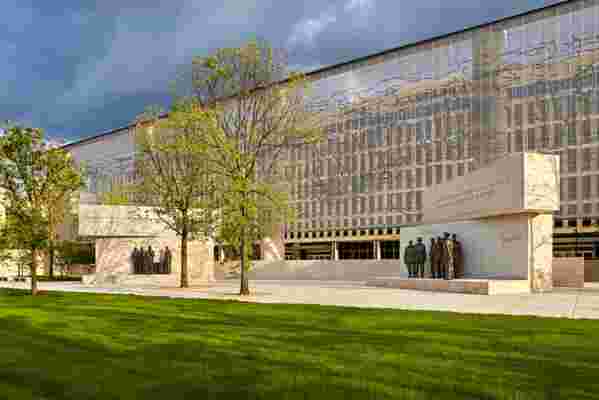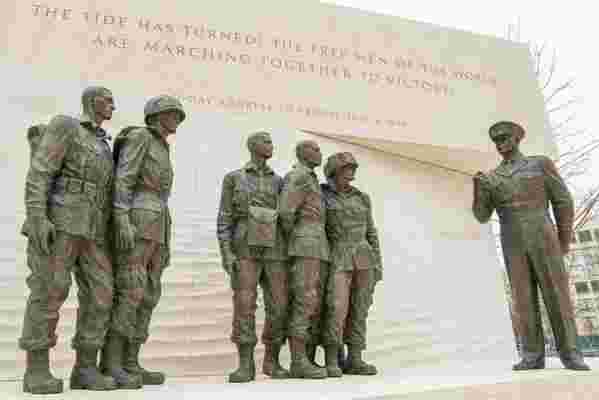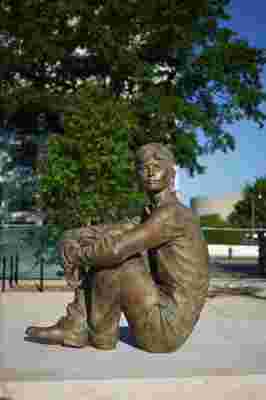Frank Gehry Explains His New Design for the National Eisenhower Memorial
Three dramatic physical representations of Dwight Eisenhower—including heroic-size sculptural elements depicting him as president of the United States, as a general in World War II, and as a young man—celebrate the trajectory of his life as the quintessential American story. On a previously overlooked site adjacent to the National Mall in Washington, D.C., architect Frank Gehry has finally seen the completion of his vision for the Dwight D. Eisenhower Memorial. The figurative monument depicts the Army general and 34th president in those two historical roles, both with his troops and in the White House. After 21 years of delays due to design negotiations between the architect’s team and the Eisenhower family, the memorial has been erected and will be dedicated on September 17.
Gehry’s memorial design is a mix of large architectural gestures, green space, and figurative sculpture, designed in collaboration with Russian-born sculptor Sergey Eylanbekov and Los Angeles–based artist and architect Tomas Osinski. On its four-acre plot, now transformed into a public park, in front of the Lyndon Baines Johnson Department of Education Building and across the street from the Air and Space Museum, the memorial features stacked slabs of pink limestone that set a backdrop for two scenes in sculpture: On the left, Eylanbekov depicts Eisenhower in his role as president surrounded by advisers in the Oval Office; on the right, as the World War II supreme Allied commander addressing his troops as they presumably prepare to battle the Nazis. Behind, a 60-foot-tall, 450-foot-wide stainless steel tapestry by Osinski, rendering the Normandy coastline during peacetime via a hand sketch by Gehry, shields the DoED’s gridded 1961 façade. In the same stone, a parapet displays the former president’s name, benches provide seating, and freestanding columns within the landscaped park serve as contemporary obelisks.

Eisenhower is seen addressing his troops, while in the background there's a 60-foot-tall, 450-foot-wide stainless steel tapestry.
Via an Eylanbekov sculpture of Eisenhower as a young man, the memorial presents his story as an example of the American dream: Having grown up of isolated origins in Kansas, he became a soldier and rapidly ascended to head a nation. The sentiment caused design strife that contributed to project delays: Gehry’s original concept included three woven metalwork tapestries with scenes including the rolling Kansas hills. Eisenhower’s family felt the focus on his achievements later in life were lost in the emphasis on his childhood, leading to a public battle that at one point caused Congress to withhold federal funding for the project. In 2016, the family approved the final design, which opens to the public on Friday. Ahead of the dedication, AD spoke with Gehry about his vision to honor Eisenhower with a memorial that transforms its site, both in the daytime and at night.

As the supreme Allied commander, this scene of Eisenhower addressing his troops is one of great significance in 20th century American history.
Architectural Digest : When you were first conceiving of the memorial design, what were the most important design elements to include?
Frank Gehry : When we started, the site was a very underutilized plot of land that had Maryland Avenue cutting through it; a community garden planted sporadically around the site was surrounded by 1950s-era federal buildings and was facing the back of the Air and Space Museum. The brief from the competition was to use the entire four acres of the site for the memorial. Having that large of a site meant that we needed some sort of unifying element: We needed to find a design element that created a backdrop to the core of the memorial, one that softened the urban elements surrounding the site, and one that prepared the visitor for the gravity of the topic. That’s how we came to the tapestry. Tapestries have been used throughout time to tell the story of cultures in war and peace. It seemed to fit.
The other important elements, of course, are the sculptures of Eisenhower as general and as president. It was important that we represent him in both cases surrounded by his team and his advisers. Ike was not a chest-pounder. He was a gracious leader who knew how to bring people together. He told his family that he never wanted to be put on a pedestal or put on a horse, so we wanted to show him with people.

The memorial includes scenes throughout Eisenhower's life, including his early days as a boy in Kansas.
AD : How does the design of the memorial both honor and encourage contemplation?
FG : The site has several scales to it. The core of the memorial includes the sculptures and the inscriptions of Eisenhower’s words. It is hard not to feel the weight of the war on General Eisenhower when you look at the tableau depicting him with the 101st Airborne Division. Eisenhower knew that he was sending these soldiers off to the most dangerous mission of their lives and that many would not survive. Looking up at the tapestry from this vantage point, you can feel the scale of the cliffs that these brave soldiers had to scale in order to beat back the Nazis. It is overwhelming. As president, Eisenhower worked quietly and diligently to keep the peace. His words speak to the dangers he saw that were trying to erode the democracy that he had fought to protect.
AD : How did you collaborate with artists for this memorial?
FG : Tomas Osinski has collaborated with me on a number of projects. With the tapestry, I had the idea, but I didn’t know how to technically execute it. When I showed him the project, Tomas right away said that he could figure it out, and by golly, he did. He invented a machine to make the tapestry and the software to run it. All along the way, throughout the various iterations, we never wanted this to feel computerized. We worked very hard to keep the handmade quality.
Sergey Eylanbokov came to us because of his ability to bring humanity to the bronze sculpture. He was very collaborative with us, sharing the early stage clay maquettes. Getting the right amount of movement and expression in the sculpture was important to bringing the president and general to life.
The memorial will have a different feel for those who visit during the day and those who do at night. This was something that Gehry sought out with his design.
AD : How does the experience of the design change during the daytime versus at nighttime?
FG : From the start, I wanted the tapestry to transform. In the daytime, I meant it to be a gauzy backdrop, something to filter the buildings around it in order that visitors could focus on the memorial. The memorial sits in front of the Department of Education. We didn’t want the people working in that building to feel the tapestry too heavily. Of course, at night, with no one in the buildings, the tapestry will be more present and legible from Independence Avenue. There is a legacy in D.C. of memorials changing from day to night, and I suppose that we wanted to be part of that history.